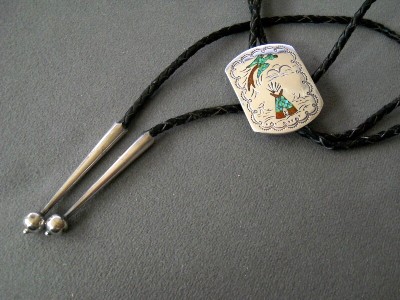Affiliate Disclaimer: We work to provide bolo ties and locate merchants who sell the products you are looking for. If you make a purchase from any of the merchants we endorse, we will earn a small commission at no additional cost to you. Thank you for your support!
Tsosie family of Navajo jewelers and their legacy in Native American jewelry

The Tsosies - A Navajo Jewelry Dynasty
Among the most revered names in Navajo jewelry lies Tsosie. Their family has steadily produced exemplary sterling silver and turquoise jewelry for over a century. Passing metalsmithing secrets across generations while advancing handcrafted Navajo artistry, the Tsosies signatures and silverwork styles charm collectors worldwide for good reason - they helped shape customs in Southwestern wearable art.
1860s Beginnings
The earliest origins of Navajo silversmithing begin shortly after the traumatic 1863 Kit Carson campaign forced Navajos on the Long Walk to Bosque Redondo reservation. There tribal members learned metalworking skills from Hispanic blacksmiths that they would soon transform into jewelry craft once resettled years later. The opportune 1880s dawn of Fred Harvey Company's push for native jewelry and a Santa Fe railroad market accelerated technique and design. Growing interest demanded more Navajo smiths learn the intricacies of hammering, heating and shaping precious metals. Among those pioneering Diné jewelers adopting these methods were Tsosie family ancestors in the late 1800s.
Their rich silver and turquoise workmanship quickly stood apart thanks success sharing knowledge across clans. As rail fans popularized Navajo jewelry, Tsosie pieces gained acclaim in national exhibitions by 1904. Their notably slim, oval ring bands - easier for women to wear - also proved widely influential as the Navajo aesthetic developed. Brothers Lee and Tom Tsosie drove demand further in the 1930s-40s by innovating beyond single bow guards and bar pins toward elaborate 5-in-1 brooches using stone inlays on coins. This frequent use of triangular turquoise set in diagonal channels came to typify signature mid-century Navajo style.
Modern Notoriety
Later generations cementing Tsosie distinction include Wilson, Allen and Leonard Tsosie. They claimed over 42 prestigious awards between 1981-1997 for raising Navajo technique standards using softer, thinner silver - making jewelry more wearable than bulky chains of years past. Delicacy required master level precision few attain. Tsosie jewelers also gained merit integrating coral and opal doublets for sharing clan wisdom with non-Navajos for educational purposes. Continuing their prolific family success, contemporary artists B&W Tsosie, Mardell Tsosie and Kim Tsosie-Jenkins rank among today's elite Navajo smiths.
Thanks to visionary early silver pioneers and award-winning contributors keeping appreciate for Navajo style thriving through changing times, the Tsosie name retains honored place in Native American jewelry. Their standout candles, cog armbands, hollow bells, overlay brick and diamond designs appear in museum exhibitions. Websites like ATADA.org that verify tribal artist work help collectors identify authentic Tsosie pieces. And leading auction houses still celebrate new Tsosie family additions that push boundaries, upholding standards of quality. Over a century strong, renowned Tsosie artistry remains metadata for evaluating authentic Navajo. Their work echoes the long storytelling and talents of Diné tribe jewelers.

Old Pawn Tsosie Bolo Ties
References
Turquoise Skies - Tsosie Family LegacyNavajo Arts and Crafts Enterprise - Tsosie Family Heritage
Smithsonian NMAI - Tsosie Family Contributions
Southwest Silver Gallery - History of the Tsosie Family
Four Winds Indian Trading Post - Tsosie Family Story





